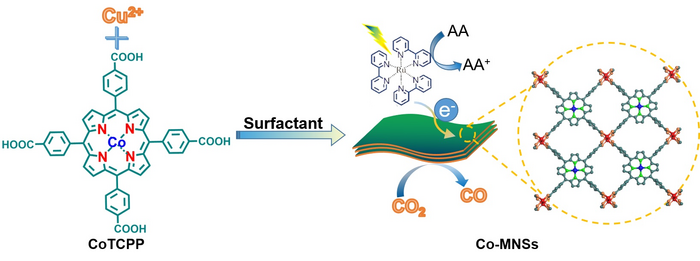One of the most efficient methods for achieving carbon neutrality with the integration of sustainable energy into the modern economy is the use of solar energy to transform CO2 into synthetic fuels.

Synthetic illustration of the ultrathin MOF nanosheet-based cobalt single-atom catalyst for visible-light-driven photocatalytic CO2-to-CO conversion. Image Credit: ©Science China Press
However, due to the high thermodynamic stability of CO2 molecules and their multiple-electron-reduction process, the effectiveness of photocatalytic CO2 conversion is severely limited. The synthesis of stable single-atom catalysts with high metal loading is advantageous to improve photocatalytic CO2 performance, but this has remained a significant challenge.
A study was conducted by researchers guided by Prof. Yongfeng Zhou and Prof. Yiyong Mai (School of Chemistry and Chemical Engineering, Shanghai Jiao Tong University) to overcome this challenge.
The researchers devised a bottom-up synthetic strategy for the creation of ultrathin MOF nanosheets coordinated with Co single atoms by directly employing CoII tetrakis(4-carboxyphenyl) porphyrin (CoTCPP) as the linkers and Cu2–(COO)4 paddlewheel cluster as the metal nodes. Bottom-up synthetic approaches avoid the time-consuming exfoliation processes and low yields associated with top-down synthetic approaches.
Furthermore, since the Co sites were coordinated within the porphyrin rings prior to MOF formation, the MOF nanosheets contained Co single atoms with a high loading of 6.0 wt.%. The acquired MOF nanosheets had an ultrathin thickness of 2.4 ± 0.5 nm and a micron-sized lateral dimension.
This large aspect-ratio 2D morphology, combined with the high content of Co single atoms, facilitated plentiful accessible active sites on the catalyst surfaces while also effectively inhibiting electron-hole recombination by narrowing charge carrier diffusion length from the material interior to the surface.
Co-MNSs displayed a high CO2-to-CO production rate of 7,041 μmol g−1h −1 and a spectacular selectivity of 86% in aqueous media under λ > 420 nm light irradiation, as a catalyst for visible-light-driven photocatalytic CO2 reduction, ranking among the top-level performances of the observed MOF-based photocatalysts.
This research paves the way for the synthesis of 2D stable single-atom catalysts with high loading of single metal atoms, as well as for future efforts to create efficient photocatalysts for important but thermodynamically difficult reactions.
Journal Reference
Zuo, Q., et al. (2023). High-loading single cobalt atoms on ultrathin MOF nanosheets for efficient photocatalytic CO2 reduction. Science China Chemistry. doi.org/10.1007/s11426-022-1498-y.